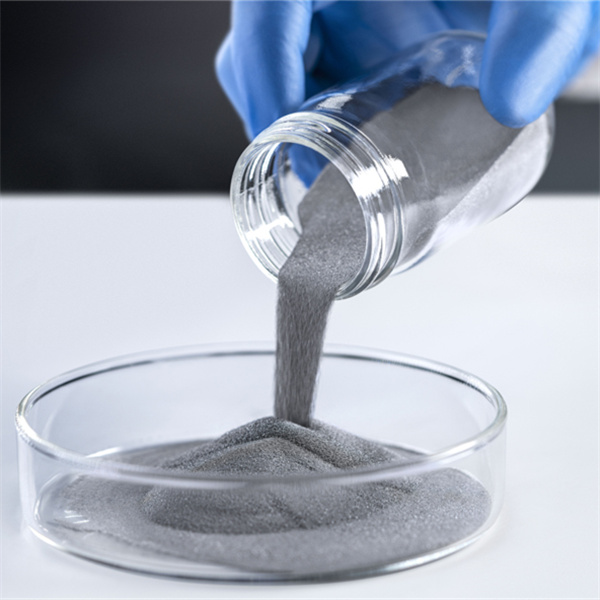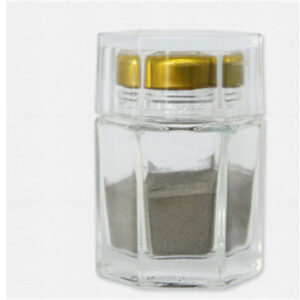bubuk aluminium untuk pencetakan 3d semakin banyak digunakan dalam manufaktur aditif untuk membuat komponen yang ringan dan berkekuatan tinggi di seluruh industri. Panduan ini memberikan gambaran umum yang komprehensif tentang bubuk aluminium untuk pencetakan 3D.
Pengantar Bubuk Aluminium untuk AM
Aluminium adalah bahan yang populer untuk pencetakan 3D karena:
- Kepadatan rendah - 2,7 g/cc
- Kekuatan spesifik yang tinggi
- Konduktivitas termal dan listrik yang sangat baik
- Ketahanan korosi yang baik
- Kemampuan las dan kemampuan mesin
- Biaya material yang rendah
Sifat-sifat utama bubuk aluminium:
- Morfologi bubuk bulat
- Distribusi ukuran partikel yang terkendali
- Tingkat kemurnian tinggi lebih dari 99,5% Al
- Berasal dari aluminium daur ulang dalam beberapa kasus
- Tersedia untuk pengaliran pengikat, DMLS, proses SLM
Serbuk aluminium memungkinkan pencetakan komponen ringan yang tidak mungkin dibuat dengan metode lain.

Jenis Serbuk Aluminium untuk Manufaktur Aditif
Berbagai serbuk paduan aluminium digunakan untuk AM:
Jenis Bubuk Aluminium untuk Pencetakan 3D
| Jenis | Deskripsi | Aplikasi |
|---|---|---|
| AlSi10Mg | Paduan cor dengan silikon dan magnesium | Kedirgantaraan, otomotif |
| AlSi7Mg | Paduan kekuatan sedang dengan Si, Mg | Mesin industri |
| 6061 | Paduan tempa kekuatan sedang dengan Mg, Si | Kurung khusus, perlengkapan |
| Seri 5XXX | Magnesium 5% untuk kekuatan | Perkakas, kelautan |
| Aluminium murni | Aluminium tanpa paduan> 99.7% | Manajemen termal, kelistrikan |
Paduan khusus sedang dikualifikasikan untuk teknik aditif agar sesuai dengan sifat paduan konvensional.
Komposisi dari bubuk aluminium untuk pencetakan 3d
Komposisi khas serbuk paduan aluminium untuk AM:
Komposisi Bubuk Cetak Aluminium
| Paduan | Al | Mg | Si | Fe | Cu | Mn |
|---|---|---|---|---|---|---|
| AlSi10Mg | Bal. | 0.2-0.5% | 9-11% | <0,55% | <0,05% | <0,45% |
| AlSi7Mg | Bal. | 0.1-0.5% | 6-8% | <1% | <0.1% | <0.1% |
| 6061 | Bal. | 0.8-1.2% | 0.4-0.8% | <0,7% | 0.15-0.4% | <0,15% |
| 5056 | Bal. | 4.5-6% | <0,4% | <0.5% | <0.1% | 0.1-0.5% |
Silikon meningkatkan kemampuan cor dan fluiditas. Magnesium meningkatkan kekuatan. Kotoran diminimalkan untuk kesesuaian AM.
Sifat Utama Bubuk Cetak Aluminium
Sifat-sifat Bubuk Cetak Aluminium
| Properti | Nilai |
|---|---|
| Kepadatan | 2,7 g/cc |
| Titik leleh | 475-650°C |
| Konduktivitas termal | 120-180 W/mK |
| Konduktivitas listrik | 35-38 MS/m |
| Kekuatan tarik | 230-520 MPa |
| Perpanjangan | 3-8% |
| Modulus Young | 68-72 GPa |
| Kekerasan | 65-100 HB |
Sifat-sifat ini membuat aluminium cocok untuk komponen cetak yang ringan, konduktif secara termal dan listrik.
Karakteristik Serbuk Aluminium untuk AM
Karakteristik Serbuk Aluminium
| Parameter | Detail | Signifikansi |
|---|---|---|
| Bentuk partikel | Bulat | Meningkatkan kemampuan mengalir |
| Distribusi ukuran | 10-100 μm | Mengontrol resolusi bagian |
| Kepadatan yang tampak | 1,2-1,8 g/cc | Mempengaruhi kepadatan bagian akhir |
| Laju aliran | 20-30 s/50g | Menunjukkan daya sebar bubuk |
| Kandungan oksida | <3% | Berdampak pada aliran serbuk dan sintering |
| Kandungan hidrogen | <0,15% | Mengurangi porositas di beberapa bagian |
Kebulatan dan distribusi ukuran partikel yang terkendali sangat penting untuk serbuk aluminium AM.
Spesifikasi untuk Bubuk Cetak Aluminium
Spesifikasi Bubuk Aluminium
| Parameter | Jangkauan/Batas | Standar |
|---|---|---|
| Ukuran partikel | 10-63 μm | ASTM B214 |
| Kepadatan yang tampak | > 0,80 g/cc | ASTM B212 |
| Laju aliran aula | <30 s/50g | ASTM B213 |
| Kandungan oksida | <3% | ASTM B237 |
| Komposisi Mg, Si | Batas paduan | ASTM B937 |
| Kotoran | Batas Fe, Cu, Mn | ASTM B937 |
Karakteristik dan komposisi serbuk utama diverifikasi terhadap spesifikasi standar.
Manfaat Penggunaan bubuk aluminium untuk pencetakan 3d
Manfaat Aluminium untuk Pencetakan 3D
- Ringan - rasio kekuatan-terhadap-berat yang tinggi
- Mengurangi limbah material
- Peningkatan kebebasan desain dan konsolidasi bagian
- Penghapusan perkakas dan pemesinan
- Fabrikasi sesuai permintaan dan tepat waktu
- Konduktivitas termal dan listrik yang tinggi
- Ketahanan korosi yang sangat baik
- Penyelesaian akhir dan pasca-pemrosesan yang baik
- Efektivitas biaya untuk produksi volume menengah
Manufaktur aditif serbuk aluminium memberikan keuntungan yang signifikan dibandingkan teknik konvensional untuk bagian struktural dan fungsional yang ringan.
Aplikasi Komponen Aluminium Cetak 3D
Aplikasi Industri Aluminium Cetak 3D
| Industri | Komponen |
|---|---|
| Dirgantara | Braket badan pesawat, penukar panas, bilah turbin |
| Otomotif | Sasis, suku cadang powertrain, interior khusus |
| Industri | Robotika, perkakas, perlengkapan, dudukan |
| Konsumen | Rumah elektronik, badan drone |
| Arsitektur | Panel dekoratif, pelapis dinding |
| Medis | Implan ortopedi, prostetik |
Manufaktur aditif memungkinkan geometri, konsolidasi, dan penyesuaian aluminium yang sebelumnya tidak mungkin dilakukan di berbagai sektor.
Bagaimana Memilih Pemasok Bubuk Printer Aluminium
Memilih Pemasok Bubuk Aluminium
- Berpengalaman memproduksi serbuk AM
- Kemampuan untuk menyesuaikan paduan dan ukuran partikel
- Kualitas dan reproduktifitas yang konsisten
- Harga yang kompetitif dan transparan
- Keahlian teknis dan dukungan pelanggan
- Analisis batch dan data sertifikasi
- Persediaan dan waktu tunggu yang lebih singkat
- Kemampuan untuk memenuhi fluktuasi permintaan
- Pengadaan yang bertanggung jawab dan berkelanjutan
Mitra serbuk aluminium yang andal memberikan serbuk yang disesuaikan dan berkualitas yang disesuaikan dengan kebutuhan aplikasi.
Produsen Bubuk Cetak Aluminium
Pemasok Bubuk Aluminium untuk AM
| Perusahaan | Lokasi |
|---|---|
| Sandvik | Jerman |
| AP&C | Kanada |
| Praxair | AMERIKA SERIKAT |
| Aditif Tukang Kayu | AMERIKA SERIKAT |
| Serbuk & Pelapis Canggih | AMERIKA SERIKAT |
| Teknologi LPW | INGGRIS |
Para pemasok terkemuka ini menyediakan ukuran partikel yang terkendali, morfologi bola, paduan khusus, dan data kualifikasi yang ekstensif untuk memastikan hasil cetakan yang optimal.
Analisis Biaya Bubuk Cetak Aluminium
Biaya Bubuk Aluminium
| Kelas | Biaya per kg |
|---|---|
| Aluminium murni | $50-$100 |
| AlSi10Mg | $55-$120 |
| Paduan 6061 | $60-$150 |
| Seri 5XXX | $65-$140 |
Harga tergantung pada komposisi paduan, tingkat pengotor, karakteristik partikel, dan volume pembelian. Penghematan biaya yang signifikan dibandingkan paduan titanium.
Perbandingan Aluminium dengan Bahan Cetak Lainnya
Perbandingan Bubuk Aluminium dengan Alternatif
| Parameter | Aluminium | Titanium | Baja tahan karat |
|---|---|---|---|
| Kepadatan (g/cc) | 2.7 | 4.5 | 8.0 |
| Kekuatan Tarik (MPa) | 230-520 | 900-1200 | 500-1000 |
| Konduktivitas termal (W/mK) | 120-180 | 7-16 | 15-30 |
| Konduktivitas listrik (MS/m) | 35-38 | 2.4 | 1.5 |
| Biaya per kg | $50-$150 | $200-$500 | $20-$50 |
| Kemampuan cetak | Adil | Sulit | Luar biasa |
Aluminium memberikan kombinasi terbaik antara kekuatan, berat, konduktivitas, dan biaya. Baja tahan karat lebih mudah dicetak tetapi lebih berat. Titanium sangat menantang.

Pertanyaan yang Sering Diajukan
T: Berapa ukuran partikel tipikal untuk bubuk aluminium AM?
J: Ukuran partikel dari 10-45 mikron adalah hal yang umum, dengan distribusi yang ketat di sekitar 20-35 mikron untuk aliran optimal dan resolusi tinggi.
T: Nilai aluminium apa yang kompatibel dengan pencetakan 3D?
J: Paduan seri AlSi10Mg, AlSi7Mg, dan seri 6xxx seperti 6061 telah memenuhi syarat. Nilai 5XXX juga semakin populer karena kekuatannya yang lebih tinggi.
T: Proses AM mana yang paling cocok untuk aluminium?
J: DMLS, SLM, dan pengaliran pengikat memungkinkan pencetakan aluminium. Pengaliran binder memberikan kecepatan pembuatan yang lebih cepat, tetapi DMLS dan SLM menawarkan sifat mekanis yang lebih baik.
T: Apakah bubuk aluminium memerlukan tindakan pencegahan penanganan khusus?
J: Aluminium yang terbagi halus dapat mudah terbakar atau meledak di udara. Kotak sarung tangan gas inert direkomendasikan untuk penyimpanan dan penanganan.
T: Apakah perlakuan panas diperlukan untuk aluminium cetak 3D?
J: Ya, perlakuan larutan, penuaan, anil, atau penghilang stres dapat dilakukan untuk mencapai sifat material dan struktur mikro yang diinginkan.
T: Permukaan akhir apa yang dapat dicapai dengan komponen aluminium AM?
J: Hasil akhir yang dicetak sekitar 15 mikron Ra dapat dihaluskan lebih lanjut hingga di bawah 1 mikron Ra dengan menggunakan media peledakan, penggerindaan, pengamplasan, dan pemolesan.
T: Dapatkah bagian cetakan aluminium cocok dengan sifat paduan massal?
J: Dengan parameter yang dioptimalkan dan pasca-pemrosesan, komponen aditif dapat mencapai sifat mekanis yang setara atau lebih baik daripada paduan aluminium yang diproses secara tradisional.
T: Prinsip desain apa yang berlaku untuk aluminium AM?
J: Orientasi cetak, penyangga minimal, jari-jari internal yang besar, dan memperhitungkan tekanan termal akan meningkatkan hasil. Ketebalan dinding di atas 1 mm lebih disukai.




